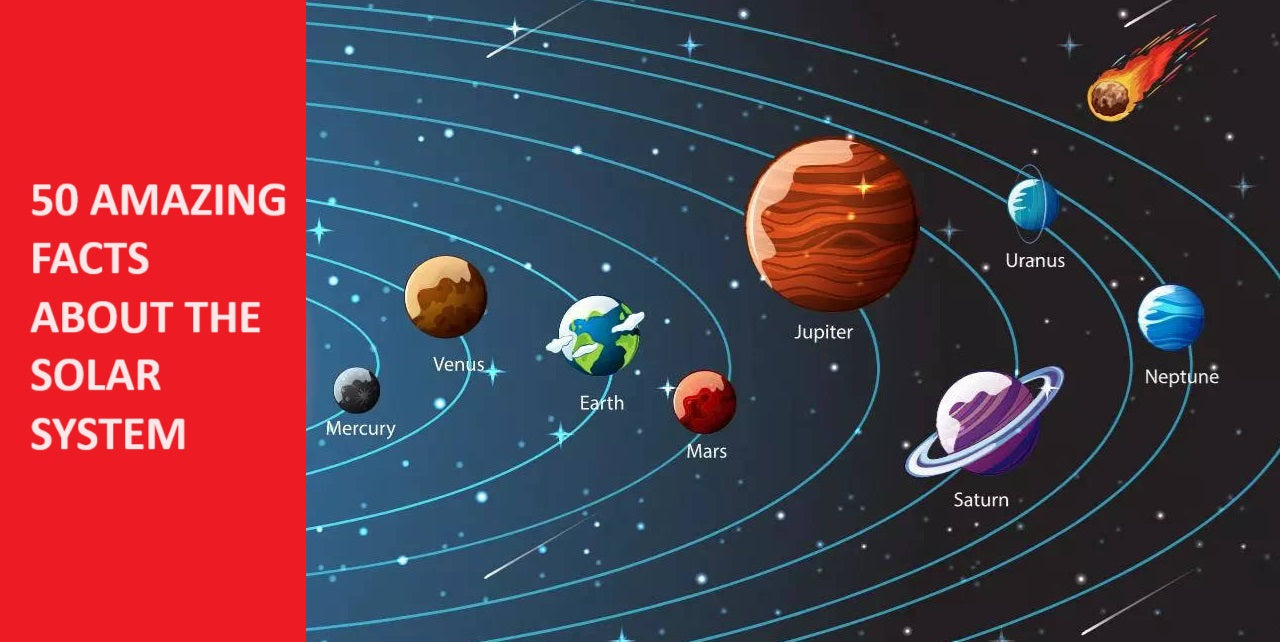Solar system
Posted by Olympiad Tester on

Fact 1: The solar system is about 4.6 billion years old.
Fact 2: The sun contains more than 99.8% of the total mass of the entire solar system.
Fact 3: There are eight recognized planets in the solar system: Mercury, Venus, Earth, Mars, Jupiter, Saturn, Uranus, and Neptune.
Fact 4: Earth is the only known planet to support life.
Fact 5: Jupiter is the largest planet in the solar system and could fit more than 1,300 Earths inside it.
Fact 6: Saturn's rings are made mostly of ice particles and dust.
Fact 7: Uranus is tilted on its side, making it the only planet to rotate in this manner.
Fact 8: Neptune has the strongest winds in the solar system, reaching speeds of over 1,500 miles per hour.
Fact 9: Pluto, once considered the ninth planet, was reclassified as a dwarf planet in 2006.
Fact 10: The Oort Cloud is a vast region containing trillions of icy bodies located at the outermost edge of the solar system.
Fact 11: The Kuiper Belt, a region beyond Neptune, is home to many dwarf planets, including Pluto.
Fact 12: The sun's gravity keeps all the planets and other objects in the solar system in orbit.
Fact 13: The asteroid belt, located between Mars and Jupiter, is a region with many rocky bodies.
Fact 14: Halley's Comet, one of the most famous comets, visits the inner solar system approximately every 76 years.
Fact 15: The sun will eventually expand into a red giant, swallowing Mercury and Venus, and possibly Earth.
Fact 16: The sun is so large that more than a million Earths could fit inside it.
Fact 17: The Great Red Spot on Jupiter is a giant storm that has been raging for at least 350 years.
Fact 18: Earth's moon is the fifth-largest moon in the solar system.
Fact 19: The sun's energy is produced through nuclear fusion, converting hydrogen into helium.
Fact 20: The Voyager 1 spacecraft, launched in 1977, is the farthest human-made object from Earth and has entered interstellar space.
Fact 21: The sun's core temperature is about 27 million degrees Fahrenheit (15 million degrees Celsius).
Fact 22: Earth is the only planet not named after a Roman or Greek god.
Fact 23: The asteroid Ceres, located in the asteroid belt, is considered both a dwarf planet and the largest object in the belt.
Fact 24: Io, one of Jupiter's moons, has more than 400 active volcanoes, making it the most geologically active object in the solar system.
Fact 25: Venus rotates on its axis in the opposite direction of most planets, including Earth, a phenomenon known as retrograde rotation.
Fact 26: The heliosphere is a vast region influenced by the sun's solar wind and magnetic fields, extending far beyond the planets.
Fact 27: The largest volcano in the solar system, Olympus Mons, is located on Mars.
Fact 28: Enceladus, a moon of Saturn, has geysers that shoot water vapor into space, hinting at a subsurface ocean.
Fact 29: The solar system is part of the Milky Way galaxy, which contains billions of stars, planets, and other celestial objects.
Fact 30: The term "light-year" is a unit of distance, representing the distance light travels in one year, approximately 5.88 trillion miles (9.46 trillion kilometers).
Fact 31: The Kuiper Belt contains icy bodies such as Pluto, Eris, Haumea, and Makemake, in addition to numerous smaller objects.
Fact 32: The solar system's two farthest dwarf planets, Eris and Sedna, have highly elliptical orbits and are located in the scattered disc.
Fact 33: Titan, Saturn's largest moon, has a thick atmosphere and lakes of liquid methane and ethane on its surface.
Fact 34: The Heliopause is the boundary where the sun's influence ends, and interstellar space begins.
Fact 35: The sun completes one orbit around the center of the Milky Way galaxy approximately every 230 million years.
Fact 36: Triton, Neptune's moon, orbits in the opposite direction of Neptune's rotation, suggesting it may be a captured Kuiper Belt object.
Fact 37: The solar system's largest moon is Ganymede, a moon of Jupiter, even larger than the planet Mercury.
Fact 38: Haumea, a dwarf planet in the Kuiper Belt, is elongated due to its rapid rotation, completing one rotation in about four hours.
Fact 39: The solar wind, a continuous flow of charged particles from the sun, creates the heliosphere, protecting the solar system from cosmic rays.
Fact 40: The Oort Cloud, a theoretical region, is believed to contain a reservoir of icy bodies and comets surrounding the sun in a vast, spherical shell.
Fact 41: Pluto has a moon named Charon, and the Pluto-Charon system is sometimes considered a binary dwarf planet system.
Fact 42: The Voyager 2 spacecraft, launched in 1977, has provided valuable data about the outer planets and is now in interstellar space.
Fact 43: The Great Dark Spot observed on Neptune by the Voyager 2 spacecraft disappeared by the time the Hubble Space Telescope observed the planet.
Fact 44: The solar system is located in one of the spiral arms of the Milky Way, known as the Orion Arm or Local Spur.
Fact 45: Comet Hale-Bopp, one of the most widely observed comets, had a bright and impressive tail visible from Earth in 1997.
Fact 46: The sun's magnetic field undergoes a complete reversal approximately every 11 years during the solar cycle.
Fact 47: Dwarf planet Eris, discovered in 2005, played a role in the reclassification of Pluto and other objects in the solar system.
Fact 48: The sun's gravity influences the motion of all objects in the solar system, keeping them in orbit.
Fact 49: Sedna, a distant object in the scattered disc, has an exceptionally long and elliptical orbit, taking thousands of years to complete.
Fact 50: The term "planet" comes from the Greek word meaning "wanderer," reflecting the way planets appear to move against the backdrop of stars.
